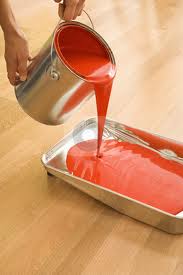Painting a Room Takes Preparation
 Painting is a job that is inexpensive on materials, but intensive on labor. In other words, you get to put in the elbow grease. It’s not difficult work, but you can’t be careless about it, either.
Painting is a job that is inexpensive on materials, but intensive on labor. In other words, you get to put in the elbow grease. It’s not difficult work, but you can’t be careless about it, either.
Depending on the quality of paint that you use, you can paint an average-sized bedroom for about $100. Plan on spending a day or so on the project. As is usually the case, painting the room is fast and easy; it’s the preparation that is the most important and time consuming.
If you can, remove everything from the room. If something is too large, put it in the middle of the room and cover it with a plastic tarp. Next, protect the carpet by running 3-inch masking tape along the baseboard. Push the tape under the base with either a wallpaper smoothing tool or a dull putty knife so as not to cut the tape.
Cover the carpet with either fabric or plastic drop cloths (fabric is better because it won’t move or become slippery). If you choose plastic, tape them down with the masking tape.
Remove all switch plate covers, air register grates and window coverings. Also, tape over outlets and switches as well as doorknobs, doorstops, hinges and strike plates. Remove light fixture covers, and cover the light bases with plastic bags and tape.
If you find old water stains on the ceiling, seal them with a stain sealer.
Sand the woodwork (if you have any) with a medium-grit sanding sponge. This will roughen the hard surface, as well as remove any high gloss finish.
Next, consider cleaning hand oil deposits from areas around light switches and door moldings with a de-glosser/cleaner. This will help the new paint properly adhere.
Prime the woodwork with a solvent-based primer. Use a small brush for the doorjambs, casings and baseboards, and a ½” nap roller for the door.
Fill in nail holes and gouges in walls and lightly sand the walls with medium grit sandpaper to knock off any bumps or imperfections from the previous paint job.
When you buy paint, stick with a higher grade from a recognized manufacturer. A gallon of quality paint will typically cover about 400 square feet. Estimate the amount of square feet you are covering (don’t forget the ceilings and closets) and divide by 400. Always round up so that you have extra paint, and realize that this number assumes only 1 coat of paint. If you are changing colors, particularly from a darker color to a lighter one, you will likely need multiple coats.
Next, roll on the ceiling paint. If you have popcorn ceiling texture, use a ¾” nap roller (if you have typical knock-down texture you can use a ½” nap). Roll on the first coat lightly in one direction, and then roll the second coat perpendicular to the first coat. You want to avoid having any popcorn texture fall from the ceiling and a light touch helps. Actually, popcorn texture should be sprayed with an airless sprayer to avoid texture on the floor.
Caulk all wall and woodwork joints with paintable caulking and smooth it out with a wet finger.
Cut in with a 3-inch brush and roll one wall at a time (“cutting in” refers to transitioning from one wall to another, particularly if the walls are different colors). This way, the wet cut-in will blend with the rolled area and will not leave a noticeable mark where the hand-painted area meets the rolled area. Use a ½” nap roller for the walls, first from top to bottom, then from side to side.
If you need to take a break, leave the roller in the tray and wrap the tray with plastic wrap. If you want to quit for the day, put the brush in a plastic bag and place it in the freezer-just thaw it out 30 minutes before use. I would replace the roller and the tray liner with new ones for the next day.